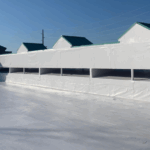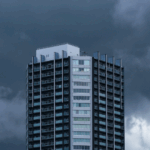
You’re in the middle of a busy workday when it happens -rain starts hammering your building, and suddenly that tiny ceiling stain transforms into a steady stream of water pouring directly onto your equipment, inventory, and office. Commercial roof failures create immediate threats to your operations, your assets, and your bottom line. The most frustrating part? These emergencies never seem to happen during convenient business hours. They strike during major storms, holiday weekends, or right before your biggest client meeting.
In these critical moments, what you do next determines whether you’re facing a minor inconvenience or a catastrophic business disruption. If you’re facing this situation right now—or you want to be prepared before it happens—this guide will walk you through exactly what to do when facing a commercial roof emergency, how to minimize damage until help arrives, and the steps needed to prevent future failures.
Why Emergency Roof Repair Can’t Wait
Every minute counts in an emergency commercial roof repair. When the rain breaches your roofing system, the clock starts ticking on a cascade of potential damages that compound with each passing hour. Water doesn’t simply drip in one spot—it travels along beams, saturates insulation, seeps into wall cavities, and compromises electrical systems. Waiting even a few hours to address an active leak can lead to:
Equipment and technology damage
Water and electronics don’t mix. A single leak above your server room or production equipment can trigger failures costing tens of thousands in replacement and downtime.
Inventory and product losses
Water-damaged inventory often can’t be salvaged or sold, leading to direct financial losses that might not be fully covered by insurance.
Structural degradation
Humidity weakens structural materials over time. What starts as a simple leak can eventually compromise support beams, deck attachments, and even foundation elements.
Mold and health concerns
Commercial spaces can develop mold colonies within hours of water exposure, creating potential health hazards for employees and customers while requiring specialized remediation.
Business interruption
Beyond physical damage, leaks force operational shutdowns, customer redirection, and productivity losses that impact your revenue stream and reputation.
This is precisely why emergency roof repairs aren’t just reactive measures. They’re essential business protection strategies that safeguard your assets, people, and profitability. We understand these stakes and have built emergency response protocols that prioritize rapid deployment, accurate assessment, and effective containment measures.
Your Emergency Response Action Plan
When facing a roof emergency, having a clear, systematic response strategy can make the difference between a minor disruption and a major disaster. The following action plan provides a framework for addressing these emergencies effectively – from the moment you discover a leak to implementing long-term solutions that prevent future failures.
Step 1: Immediate Damage Control Measures
When you discover an active roof leak, taking swift action can significantly limit interior damage before professional help arrives.
- Safety first: If water is near electrical outlets, equipment, or ceiling fixtures, shut off power to affected areas immediately through your breaker panel to prevent shock hazards.
- Contain the water: Position containers, buckets, or trash cans under active drips. For larger leaks, create water channels using plastic sheeting that direct water toward containers rather than across floors.
- Protect valuable assets: Quickly cover computers, inventory, documents, and furniture with waterproof tarps or heavy plastic sheeting. Move smaller items away from the affected area if possible.
- Document the damage: Take clear photos and videos of the leak and any damaged property for insurance purposes. Note the time and date of discovery and any relevant weather conditions.
- Limit access: Establish a safety perimeter around the affected area using caution tape or impromptu barriers to prevent slip-and-fall accidents.
After implementing these immediate measures, it’s time to call in professional help – specifically, a commercial roofing contractor with emergency response capabilities.
Step 2: Selecting the Right Emergency Response Team
Not all roofing contractors are equipped to handle commercial emergencies effectively. Many residential roofers lack experience with the complex systems found on commercial buildings, and general contractors rarely maintain 24/7 response teams. When selecting an emergency response partner, prioritize these qualities:
- Commercial-specific expertise: Look for contractors who specialize in the type of commercial roofing system on your building—whether it’s modified bitumen, TPO, EPDM or metal roofing.
- 24/7 availability: True emergency response means round-the-clock availability, including weekends and holidays when many roofing emergencies occur.
- Rapid deployment capability: Ask about their average response time for emergency calls and whether they maintain emergency materials and equipment ready for immediate use.
- Proper insurance and licensing: Even in emergencies, verify that your contractor carries adequate liability insurance and follows proper safety protocols.
- Clear communication protocols: Your emergency team should provide direct contact with technicians, transparent pricing for emergency services, and regular updates throughout the response process.
Our technicians are trained in rapid assessment and containment strategies for all major commercial roofing systems.
“Commercial roof emergencies require a fundamentally different approach than scheduled repairs. Our emergency teams are trained to think in terms of business continuity first – how can we stop the water, secure the space, and get operations back on track as quickly as possible? The comprehensive repair plan comes later, but those first few hours are about protecting what matters most to our clients.” – Rick Dodaj, Founder of Silicoat Roofing.
Step 3: Developing Your Long-Term Roof Recovery Plan
Once the immediate crisis is controlled, the emergency team shifts focus to developing a permanent solution tailored to your building’s specific needs, budget constraints, and operational requirements. This recovery planning phase should include:
- Comprehensive damage assessment: Beyond the obvious leak points, make sure they inspect for hidden damage to insulation, deck attachment, adjacent roofing areas, and supporting structures.
- Root cause analysis: Understanding why the failure occurred helps prevent future issues. Was it drainage related? Age and material deterioration? Impact damage? Installation defects? Identifying the underlying cause shapes the repair approach.
- Repair vs. restoration options: For some buildings, targeted repairs make the most sense. For others with multiple issues or aging systems, restoration with protective coatings can extend life while rebuilding waterproofing capability.
- Budgeting and timeline planning: The emergency team needs to provides clear, itemized cost projections with options at different investment levels, allowing you to make informed decisions balancing immediate needs with long-term facility management.
- Warranty and protection planning: Every permanent repair includes appropriate warranty coverage, plus recommendations for ongoing inspection and maintenance to prevent future emergencies.
Silicoat Roofing specializes in developing these recovery plans with minimal business disruption in mind. We schedule work around your operational needs whenever possible, using advanced techniques that reduce noise, odor, and interference with your daily activities.

Preventing the Next Emergency
While not every leak can be predicted, many can be prevented. That’s the power of proactive roof maintenance and regular inspections. Besides, commercial roof emergencies rarely occur without warning signs—most give subtle indicators well before catastrophic failure. According to FEMA’s Building Science Resources, proper roof maintenance is a critical component of disaster mitigation strategy for commercial buildings. Their research indicates that well-maintained roofing systems are significantly more resilient during severe weather events, potentially preventing catastrophic failures that lead to business interruption and property damage.
Implementing a Preventative Maintenance Strategy
The most cost-effective approach to commercial roofing care is developing a systematic preventative maintenance program. An effective strategy includes:
Scheduled professional inspections
Professional inspections should be conducted at least twice yearly – typically in spring and fall, to assess weather impact on roofs and commercial building performance – plus after any major storm event. These inspections identify potential failure points before they become active leaks.
Drainage system maintenance
Clogged drains and gutters remain the leading cause of preventable roof leaks. Regular cleaning of drainage pathways prevents the pooling water that eventually finds its way into your building.
Early intervention repairs
Addressing minor issues like loose flashings, small punctures, or early membrane deterioration costs a fraction of emergency repairs while preventing water damage to internal systems.
Protective coating applications
Modern materials, like UV-resistant roof coatings, can add years of protection to aging roofs while improving energy efficiency through reflective properties. These coatings are particularly effective when applied before major leaks develop.
Documentation and planning
Maintaining detailed records of all roof activities, repairs, and inspections creates a historical perspective that helps identify patterns and plan for eventual replacement at the most advantageous time.
Silicoat Roofing offers customized repair and maintenance programs scaled to your building size, roof complexity, and budget requirements. Our proactive clients report experiencing fewer emergency calls and typically extend their roof lifespans beyond manufacturer estimates.

Common Questions About Emergency Roof Repair
Are emergency roof repairs significantly more expensive than scheduled repairs?
Emergency services do carry premium rates due to the immediate deployment of resources outside normal business hours. However, the cost difference is typically far less than the potential damage prevented by rapid response.
Can my building remain operational during emergency repairs?
In most cases, yes. Our temporary containment strategies are specifically designed to allow business continuity while protecting assets. We coordinate closely with facility managers to establish work zones that minimize disruption to your operations.
How do I know if my roof damage qualifies as an emergency?
Any active water intrusion into occupied spaces constitutes an emergency, as does structural damage that compromises roof integrity. If you’re uncertain, our telephone assessment can help determine the appropriate response level for your situation.
Does Silicoat Roofing handle all types of commercial roofing systems?
Yes, our emergency teams are trained and equipped to work with all major commercial roofing types, including single-ply membranes (TPO, EPDM, PVC), modified bitumen, built-up roofing (BUR), metal panel systems, spray polyurethane foam, and concrete roof decks.
Don’t Wait for the Next Storm
Emergency roof repair capabilities are something you hope never to need, but when water starts coming through your ceiling, having a reliable partner makes all the difference. Silicoat Roofing has built its reputation on responsive, effective emergency services backed by long-term solutions that keep businesses operating without interruption.
Whether you’re currently facing an active leak or want to be prepared before the next major storm, contact us today to learn more about our emergency response protocols and preventative maintenance programs. Our commercial roofing specialists can develop a custom plan that protects your building, your operations, and your peace of mind.
Remember: When it comes to commercial roof emergencies, the right call at the right time can save thousands in damages and business interruption. Don’t wait until water is pouring through your ceiling—be prepared with our emergency response team on speed dial.
About the Author
Rick Dodaj is the founder and CEO of Silicoat Roofing, specializing in commercial roofing solutions that protect businesses and their investments. With extensive experience in commercial roofing, Rick leads a team dedicated to providing cost-effective, long-lasting roofing solutions. Connect with him on LinkedIn to learn more about commercial roof maintenance and protection strategies.


 Previous Post
Previous Post Next Post
Next Post